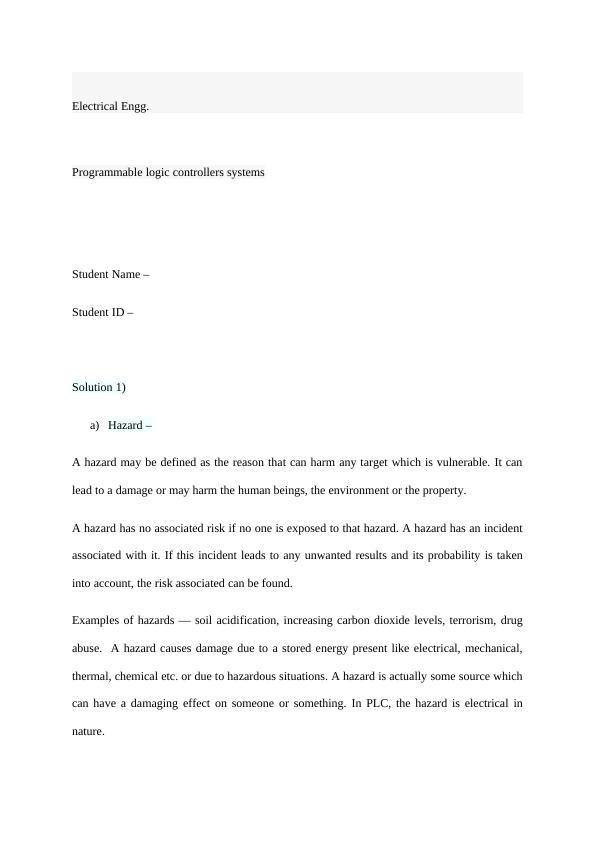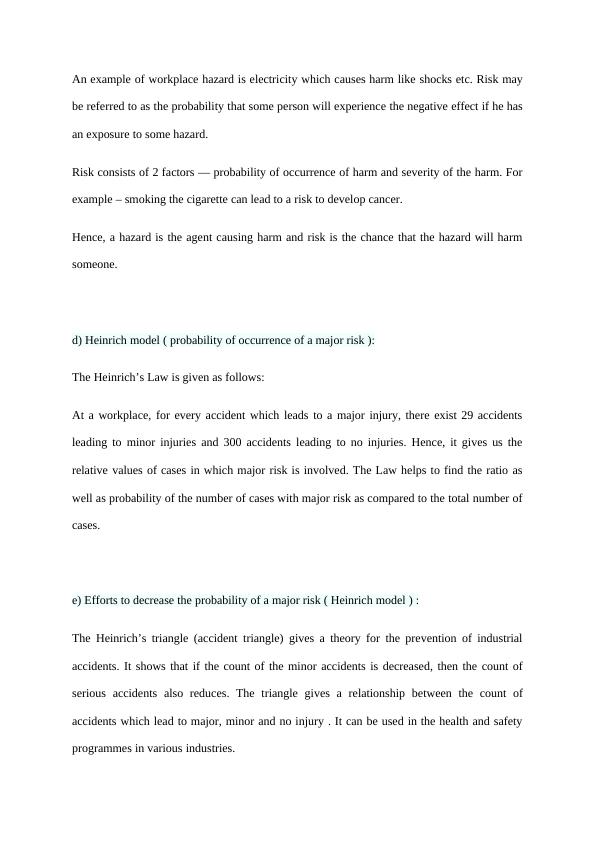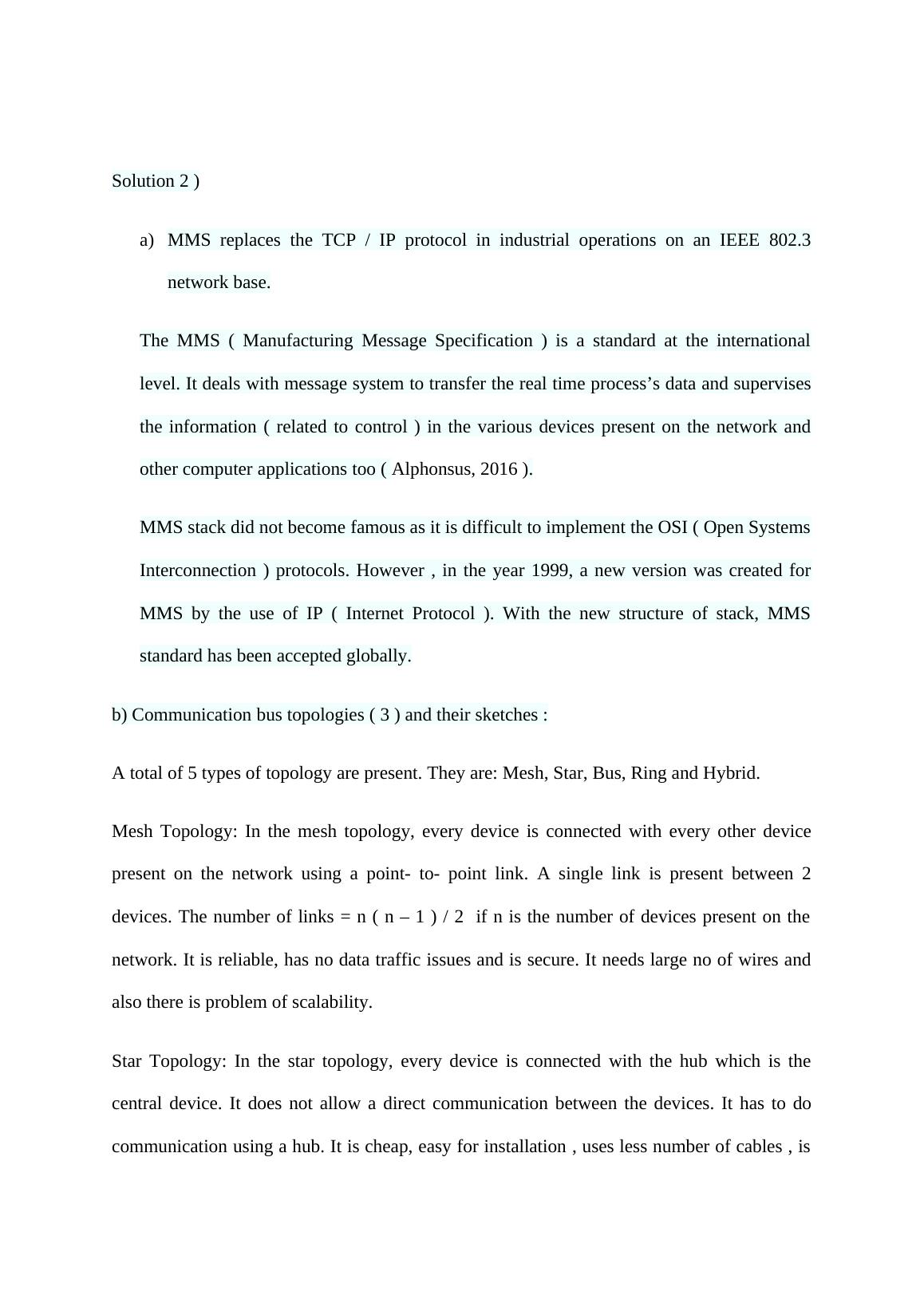Electrical Engg Solution 2022
Added on 2022-10-11
14 Pages2822 Words24 Views
Electrical Engg.
Programmable logic controllers systems
Student Name –
Student ID –
Solution 1)
a) Hazard –
A hazard may be defined as the reason that can harm any target which is vulnerable. It can
lead to a damage or may harm the human beings, the environment or the property.
A hazard has no associated risk if no one is exposed to that hazard. A hazard has an incident
associated with it. If this incident leads to any unwanted results and its probability is taken
into account, the risk associated can be found.
Examples of hazards — soil acidification, increasing carbon dioxide levels, terrorism, drug
abuse. A hazard causes damage due to a stored energy present like electrical, mechanical,
thermal, chemical etc. or due to hazardous situations. A hazard is actually some source which
can have a damaging effect on someone or something. In PLC, the hazard is electrical in
nature.
Programmable logic controllers systems
Student Name –
Student ID –
Solution 1)
a) Hazard –
A hazard may be defined as the reason that can harm any target which is vulnerable. It can
lead to a damage or may harm the human beings, the environment or the property.
A hazard has no associated risk if no one is exposed to that hazard. A hazard has an incident
associated with it. If this incident leads to any unwanted results and its probability is taken
into account, the risk associated can be found.
Examples of hazards — soil acidification, increasing carbon dioxide levels, terrorism, drug
abuse. A hazard causes damage due to a stored energy present like electrical, mechanical,
thermal, chemical etc. or due to hazardous situations. A hazard is actually some source which
can have a damaging effect on someone or something. In PLC, the hazard is electrical in
nature.

An example of workplace hazard is electricity which causes harm like shocks etc. Risk may
be referred to as the probability that some person will experience the negative effect if he has
an exposure to some hazard.
b) Risk –
A risk may be defined as the probability that when something is exposed to a hazard then it
will have some negative results.
Risk consists of 2 factors — probability of occurrence of harm and severity of the harm. For
example – smoking the cigarette can lead to a risk to develop cancer.
Hence, a hazard is the agent causing harm and risk is the chance that the hazard will harm
someone.
c) Difference between a hazard and a risk –
A hazard has no associated risk if no one is exposed to that hazard. A hazard has an incident
associated with it. If this incident leads to any unwanted results and its probability is taken
into account, the risk associated can be found.
Examples of hazards — soil acidification, increasing carbon dioxide levels, terrorism, drug
abuse etc. A hazard causes damage due to a stored energy present like electrical, mechanical,
thermal, chemical etc. or due to hazardous situations. A hazard is actually some source which
can have a damaging effect on someone or something.
be referred to as the probability that some person will experience the negative effect if he has
an exposure to some hazard.
b) Risk –
A risk may be defined as the probability that when something is exposed to a hazard then it
will have some negative results.
Risk consists of 2 factors — probability of occurrence of harm and severity of the harm. For
example – smoking the cigarette can lead to a risk to develop cancer.
Hence, a hazard is the agent causing harm and risk is the chance that the hazard will harm
someone.
c) Difference between a hazard and a risk –
A hazard has no associated risk if no one is exposed to that hazard. A hazard has an incident
associated with it. If this incident leads to any unwanted results and its probability is taken
into account, the risk associated can be found.
Examples of hazards — soil acidification, increasing carbon dioxide levels, terrorism, drug
abuse etc. A hazard causes damage due to a stored energy present like electrical, mechanical,
thermal, chemical etc. or due to hazardous situations. A hazard is actually some source which
can have a damaging effect on someone or something.

An example of workplace hazard is electricity which causes harm like shocks etc. Risk may
be referred to as the probability that some person will experience the negative effect if he has
an exposure to some hazard.
Risk consists of 2 factors — probability of occurrence of harm and severity of the harm. For
example – smoking the cigarette can lead to a risk to develop cancer.
Hence, a hazard is the agent causing harm and risk is the chance that the hazard will harm
someone.
d) Heinrich model ( probability of occurrence of a major risk ):
The Heinrich’s Law is given as follows:
At a workplace, for every accident which leads to a major injury, there exist 29 accidents
leading to minor injuries and 300 accidents leading to no injuries. Hence, it gives us the
relative values of cases in which major risk is involved. The Law helps to find the ratio as
well as probability of the number of cases with major risk as compared to the total number of
cases.
e) Efforts to decrease the probability of a major risk ( Heinrich model ) :
The Heinrich’s triangle (accident triangle) gives a theory for the prevention of industrial
accidents. It shows that if the count of the minor accidents is decreased, then the count of
serious accidents also reduces. The triangle gives a relationship between the count of
accidents which lead to major, minor and no injury . It can be used in the health and safety
programmes in various industries.
be referred to as the probability that some person will experience the negative effect if he has
an exposure to some hazard.
Risk consists of 2 factors — probability of occurrence of harm and severity of the harm. For
example – smoking the cigarette can lead to a risk to develop cancer.
Hence, a hazard is the agent causing harm and risk is the chance that the hazard will harm
someone.
d) Heinrich model ( probability of occurrence of a major risk ):
The Heinrich’s Law is given as follows:
At a workplace, for every accident which leads to a major injury, there exist 29 accidents
leading to minor injuries and 300 accidents leading to no injuries. Hence, it gives us the
relative values of cases in which major risk is involved. The Law helps to find the ratio as
well as probability of the number of cases with major risk as compared to the total number of
cases.
e) Efforts to decrease the probability of a major risk ( Heinrich model ) :
The Heinrich’s triangle (accident triangle) gives a theory for the prevention of industrial
accidents. It shows that if the count of the minor accidents is decreased, then the count of
serious accidents also reduces. The triangle gives a relationship between the count of
accidents which lead to major, minor and no injury . It can be used in the health and safety
programmes in various industries.

Solution 2 )
a) MMS replaces the TCP / IP protocol in industrial operations on an IEEE 802.3
network base.
The MMS ( Manufacturing Message Specification ) is a standard at the international
level. It deals with message system to transfer the real time process’s data and supervises
the information ( related to control ) in the various devices present on the network and
other computer applications too ( Alphonsus, 2016 ).
MMS stack did not become famous as it is difficult to implement the OSI ( Open Systems
Interconnection ) protocols. However , in the year 1999, a new version was created for
MMS by the use of IP ( Internet Protocol ). With the new structure of stack, MMS
standard has been accepted globally.
b) Communication bus topologies ( 3 ) and their sketches :
A total of 5 types of topology are present. They are: Mesh, Star, Bus, Ring and Hybrid.
Mesh Topology: In the mesh topology, every device is connected with every other device
present on the network using a point- to- point link. A single link is present between 2
devices. The number of links = n ( n – 1 ) / 2 if n is the number of devices present on the
network. It is reliable, has no data traffic issues and is secure. It needs large no of wires and
also there is problem of scalability.
Star Topology: In the star topology, every device is connected with the hub which is the
central device. It does not allow a direct communication between the devices. It has to do
communication using a hub. It is cheap, easy for installation , uses less number of cables , is
a) MMS replaces the TCP / IP protocol in industrial operations on an IEEE 802.3
network base.
The MMS ( Manufacturing Message Specification ) is a standard at the international
level. It deals with message system to transfer the real time process’s data and supervises
the information ( related to control ) in the various devices present on the network and
other computer applications too ( Alphonsus, 2016 ).
MMS stack did not become famous as it is difficult to implement the OSI ( Open Systems
Interconnection ) protocols. However , in the year 1999, a new version was created for
MMS by the use of IP ( Internet Protocol ). With the new structure of stack, MMS
standard has been accepted globally.
b) Communication bus topologies ( 3 ) and their sketches :
A total of 5 types of topology are present. They are: Mesh, Star, Bus, Ring and Hybrid.
Mesh Topology: In the mesh topology, every device is connected with every other device
present on the network using a point- to- point link. A single link is present between 2
devices. The number of links = n ( n – 1 ) / 2 if n is the number of devices present on the
network. It is reliable, has no data traffic issues and is secure. It needs large no of wires and
also there is problem of scalability.
Star Topology: In the star topology, every device is connected with the hub which is the
central device. It does not allow a direct communication between the devices. It has to do
communication using a hub. It is cheap, easy for installation , uses less number of cables , is

End of preview
Want to access all the pages? Upload your documents or become a member.
Related Documents
Hazard Identification, Risk Assessment and Hazard Management in Aviationlg...
|4
|1070
|223
Work Health and Safetylg...
|5
|1028
|412
WORKPLACE HEALTH & SAFETY; TRAFFIC CONTROL!lg...
|10
|1474
|290
Hazard Preparedness and Action Plan Case Study 2022lg...
|9
|4022
|23
Health and Safety in Health and Social Carelg...
|11
|2278
|314
Incident at the Naj Group of Collegeslg...
|7
|1823
|47
